| ________________
CM . . .
. Volume XV Number 10. . . .January 9, 2009 
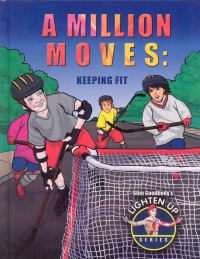 |
A Million Moves: Keeping Fit. (Slim Goodbody's Lighten Up!).
John Burstein.
St. Catharines, ON: Crabtree, 2008.
32 pp., pbk. & hc., $10.95 (pbk.), $20.76 (hc.).
ISBN 978-0-7787-3930-2 (pbk.), ISBN 978-0-7787-3912-8 (hc.).
Subject Headings:
Exercise-Health aspects-Juvenile literature.
Physical fitness-Juvenile literature.
Grades 3-6 / Ages 8-11.
Review by Gail Hamilton.
*** /4
|
| |
|
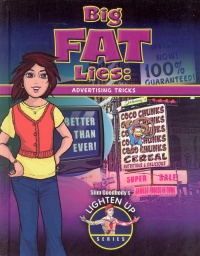 |
Big Fat Lies: Advertising Tricks. (Slim Goodbody's Lighten Up!).
John Burstein.
St. Catharines, ON: Crabtree, 2008.
32 pp., pbk. & hc., $10.95 (pbk.), $20.76 (hc.).
ISBN 978-0-7787-3931-9 (pbk.), ISBN 978-0-7787-3913-5 (hc.).
Subject Heading:
Advertising-Food-Juvenile literature.
Grades 3-6 / Ages 8-11.
Review by Gail Hamilton.
*** /4
|
| |
|
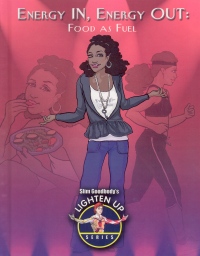 |
Energy In, Energy Out: Food as Fuel. (Slim Goodbody's Lighten Up!).
John Burstein.
St. Catharines, ON: Crabtree, 2008.
32 pp., pbk. & hc., $10.95 (pbk.), $20.76 (hc.).
ISBN 978-0-7787-3932-6 (pbk.), ISBN 978-0-7787-3914-2 (hc.).
Subject Headings:
Body weight-regulation-Juvenile literature.
Nutrition-Juvenile literature.
Energy metabolism-Juvenile literature.
Grades 3-6 / Ages 8-11.
Review by Gail Hamilton.
*** /4
|
| |
|
 |
Fast Food: Slowing Us All Down. (Slim Goodbody's Lighten Up!).
John Burstein.
St. Catharines, ON: Crabtree, 2008.
32 pp., pbk. & hc., $10.95 (pbk.), $20.76 (hc.).
ISBN 978-0-7787-3933-3 (pbk.), ISBN 978-0-7787-3915-9 (hc.).
Subject Headings:
Convenience foods-Juvenile literature.
Food-Fat content-Juvenile literature.
Nutrition-Juvenile literature.
|
Fast food restaurants-Juvenile literature.
Grades 3-6 / Ages 8-11.
Review by Gail Hamilton.
*** /4
|
| |
|
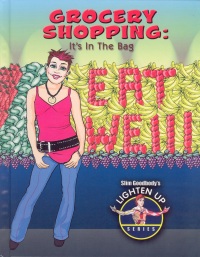 |
Grocery Shopping: It's in the Bag. (Slim Goodbody's Lighten Up!).
John Burstein.
St. Catharines, ON: Crabtree, 2008.
32 pp., pbk. & hc., $10.95 (pbk.), $20.76 (hc.).
ISBN 978-0-7787-3934-0 (pbk.), ISBN 978-0-7787-3916-6 (hc.).
Subject Headings:
Nutrition-Juvenile literature.
Grocery shopping-Juvenile literature.
Grades 3-6 / Ages 8-11.
Review by Gail Hamilton.
*** /4
|
| |
|
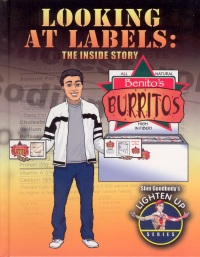 |
Looking at Labels: The Inside Story. (Slim Goodbody's Lighten Up!).
John Burstein.
St. Catharines, ON: Crabtree, 2008.
32 pp., pbk. & hc., $10.95 (pbk.), $20.76 (hc.).
ISBN 978-0-7787-3935-7 (pbk.), ISBN 978-0-7787-3917-3 (hc.).
Subject Headings:
Nutrition-Juvenile literature.
Food-Labeling-Juvenile literature.
Food-Composition-Juvenile literature.
Grades 3-6 / Ages 8-11.
Review by Gail Hamilton.
*** /4
|
| |
|
 |
Snack Attack: Unhealthy Treats. (Slim Goodbody's Lighten Up!).
John Burstein.
St. Catharines, ON: Crabtree, 2008.
32 pp., pbk. & hc., $10.95 (pbk.), $20.76 (hc.).
ISBN 978-0-7787-3936-4 (pbk.), ISBN 978-0-7787-3918-0 (hc.).
Subject Headings:
Nutrition-Juvenile literature.
Snack foods-Juvenile literature.
Grades 3-6 / Ages 8-11.
Review by Gail Hamilton.
*** /4
|
| |
|
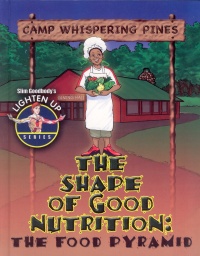 |
The Shape of Good Nutrition: The Food Pyramid. (Slim Goodbody's Lighten Up!).
John Burstein.
St. Catharines, ON: Crabtree, 2008.
32 pp., pbk. & hc., $10.95 (pbk.), $20.76 (hc.).
ISBN 978-0-7787-3937-1 (pbk.), ISBN 978-0-7787-3918-0 (hc.).
Subject Headings:
Nutrition-Juvenile literature.
Food-Juvenile literature.
Grades 3-6 / Ages 8-11.
Review by Gail Hamilton.
*** /4
|
| |
|

excerpt:
You might have to go for a whole grains hunt! Companies sometimes pay grocery stores to put their products at eye level or in places where the customer is bound to notice them. Less healthy grains like sugary cereals, fattening macaroni and cheese, or white bread are often at eye height. Companies think those items are more appealing and that their placement will make you grab them from the shelves. (From Grocery Shopping: It's in the Bag.)
Slim Goodbody (aka John Burstein), the starring character of the PBS television series, The Inside Story, now hosts the National Bodyology Tour, a musical show that explains the inner workings and the care of the human body. An offshoot of the show is this eight-volume "Lighten Up" series which teaches readers how to get and maintain a healthy body through proper food choices and exercise. With so many North American children becoming increasingly overweight and physically unfit, this series is very timely indeed. Written in a narrative style, interspersed with conversation and first-person accounts, the books have 13 chapters each, plus a table of contents, a glossary, an index and a page listing a few web sites for further information. Although the books have an American slant - there are referrals to the President's Challenge fitness program, and the Food Pyramid - this does not affect the reader's understanding of the concepts presented. In fact, any time a measurement is given in Imperial form, its metric counterpart is written in parentheses, and on nutrition labels, the amounts are always given in metric form. Each title features a different character who is learning about a particular aspect of nutrition or fitness. Fact boxes, entitled "Slim Goodbody Says," provide tips, exercises and more detailed information. Obviously, there is some overlap among the titles, specifically reading nutrition labels on packaged foods, the "Go, Slow and Whoa" foods, steps in decision-making as it pertains to healthy choices, and the importance of becoming a health advocate.
Though the target audience, according to the publisher, is ages 7-12, the text describes scenarios that are about older youth (for example, one title features a boy who obtains a job at a fast food restaurant) and the cartoon illustrations also portray teens rather than kids. On the positive side, different races are represented in the illustrations, as are people with physical disabilities. Labels, charts and sketches are also included.
A Million Moves: Keeping Fit explains the health benefits of physical fitness. The five main areas of fitness - muscle strength, muscle endurance, heart and lung endurance and flexibility - are described along with exercises to complement each one. A "Move It!" chart provides a simple guide to different types of movement for healthy body composition and optimum fitness. Other topics include the importance of warm-ups prior to exercising, drinking plenty of water, proper workout clothing, treating injuries and goal setting related to physical fitness.
Big Fat Lies: Advertising Tricks teaches readers how to view or listen to ads critically. In this title, a young girl spends some time at her uncle's advertising agency which has to come up with an ad campaign for a breakfast cereal. She learns about ad techniques, such as the bandwagon approach and using celebrity spokespersons to endorse a product, as well as about careful wording, the work of a food stylist and a package designer, and the strategies used to influence consumers' behaviour.
Energy In, Energy Out: Food as Fuel explains the Body Mass Index (BMI), basal metabolic rate, and how many calories are required daily for boys versus girls, and for different ages and activity levels. A kid-friendly approach to making healthy food choices is provided: the "Go, Slow and Whoa" chart. "Go" foods are the healthy fruits and vegetables which can be eaten in fairly large amounts, while some of the "Slow" foods are sports drinks, popcorn and white bread, which should be eaten in moderation, and the "Whoa" foods are those that contain lots of fat, calories and sugar. The roles that heredity, portion size, physical activity and calories play in overcoming obesity are also discussed. Finally, the importance of setting realistic goals in terms of healthy weight loss and exercise are presented along with some information about eating disorders.
Fast Food: Slowing Us All Down follows a young man as he works at a fast food restaurant and notices a change in his energy level after frequent sampling of his restaurant's fare. In this title, readers will learn how to compare nutrition labels on similar foods, how to identify the presence of sugars by the "ose" suffix, how to make better choices when dining out, the differences between cooking methods (for example, grilled versus fried foods), and how condiments add calories to a dish. The physical effects (e.g. sluggishness, acne) of eating fast food on a regular basis are also covered.
Grocery Shopping: It's in the Bag provides information about healthy grocery shopping and the Food Pyramid. This title examines store layout and supermarket tricks, such as end of aisle displays which lead shoppers to believe that the item is on sale, and "checkout traps," displays of candy bars and other impulse buys that one must pass on the way to the cashier. Each of the food groups is discussed, as well as the dangers of hydrogenated oils, and there is a chart-form summary of the healthiest foods. There is some overlap in this title of information presented in the other books, specifically advertising techniques and label reading.
In Looking at Labels: The Inside Story, readers will meet Carlos who wants to market his mom's fantastic burritos. As he searches for ways to do this, he learns about serving sizes, analyzing foods in a lab, the percentage daily value of various nutrients in foods, the types of nutrients (dietary fiber, Vitamins C and A, iron and calcium, in this case), truthful advertising, expiration dates and government regulations about wording on food labels, particularly since so many people now have food allergies. One interesting fact is that only eight foods account for 90% of all food allergies.
Snack Attack: Unhealthy Treats focuses on healthy snacks and beverages. In this title, there is plenty of label analysis and more specific information about the Go, Slow and Whoa foods in terms of number of calories and percentages of "bad" nutrients. The author claims that snacking and watching television seem to go hand in hand, a recipe for disaster if kids choose unhealthy snacks and a sedentary lifestyle. Recipes for some healthy snacks are provided on the web site at the back of the book.
The Shape of Good Nutrition: The Food Pyramid introduces the elements of the Food Pyramid - carbs, proteins, minerals, vitamins, fats and water - and explains their functions in the human body. Selecting whole grains, colourful fruits and vegetables (fresh versus canned in syrup), lean meats and protein alternatives such as legumes, and lower fat dairy products are other topics discussed. There is information about the cautionary use of salt and salty foods and the different types of oils. Finally, readers will learn easy ways to judge portion sizes, one example being that a 5 ½ oz. (156g) serving of meat is about the size of two decks of cards.
Recommended.
Gail Hamilton is a teacher-librarian in Winnipeg, MB.

To comment
on this title or this review, send mail to cm@umanitoba.ca.
Copyright © the Manitoba Library Association. Reproduction for personal
use is permitted only if this copyright notice is maintained. Any
other reproduction is prohibited without permission.
NEXT REVIEW |
TABLE OF CONTENTS FOR THIS ISSUE
- January 9, 2009.
AUTHORS |
TITLES |
MEDIA REVIEWS |
PROFILES |
BACK ISSUES |
SEARCH |
CMARCHIVE |
HOME |







